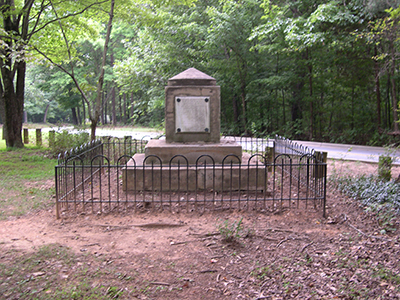Sumner, Jethro
1733–March 1785
 Jethro Sumner, Revolutionary general, tavern keeper, and planter, was born in Nansemond County, Va., where his grandfather, William, had settled in 1691. He was the son of Jethro and Margaret Sullivan Sumner. Jethro served in the Virginia militia from 1755 to 1761 during the French and Indian War; he rose to the rank of lieutenant and served as commander of Fort Bedford in 1760. Sometime before the fall of 1764 he moved to North Carolina, where he married Mary, the daughter of William and Christian Hurst of Granville County. His wife's sizable inheritance allowed him to establish himself as a tavern keeper and planter at the county seat of Bute (later Warren) County. By 1768 he had risen to justice of the peace, and he served as sheriff from 1772 to 1777.
Jethro Sumner, Revolutionary general, tavern keeper, and planter, was born in Nansemond County, Va., where his grandfather, William, had settled in 1691. He was the son of Jethro and Margaret Sullivan Sumner. Jethro served in the Virginia militia from 1755 to 1761 during the French and Indian War; he rose to the rank of lieutenant and served as commander of Fort Bedford in 1760. Sometime before the fall of 1764 he moved to North Carolina, where he married Mary, the daughter of William and Christian Hurst of Granville County. His wife's sizable inheritance allowed him to establish himself as a tavern keeper and planter at the county seat of Bute (later Warren) County. By 1768 he had risen to justice of the peace, and he served as sheriff from 1772 to 1777.
Sumner represented Bute County in the North Carolina Provincial Congress that met in August–September 1775 and elected him a major of the minutemen of Halifax County. In November he marched to the aid of the Virginians near Norfolk. After his election by the North Carolina Provincial Congress as colonel of the Third Regiment of North Carolina Continentals, he went to the Lower Cape Fear and from there to Charleston, S.C., where in June 1776 he and his troops assisted in that town's defense against the British. Later he joined Major General Charles Lee, commanding general of the Southern Department, on a projected expedition against Florida, but in September he left the troops in Savannah to return to North Carolina for supplies. The following spring he led his regiment north and joined General George Washington's army at Morristown, N.J. He and his regiment served with Washington through the Battles of Brandywine and Germantown and endured the terrible winter at Valley Forge. Illness in the spring of 1778 forced Sumner to return to North Carolina. During the summer he recruited for the North Carolina Continental regiments.
The Continental Congress elected Sumner brigadier general on January 9, 1779. The next spring he led a brigade of newly recruited Continentals to South Carolina, where he commanded the right wing of the assault on the enemy troops at the Battle of Stono Ferry on June 20th. Afterwards he fell into a "low state of Health" and returned to North Carolina, where for more than a year he recruited for the North Carolina regiments. He then was named commanding general of a brigade of militia that he marched to the southern part of the state to aid in the defense against an invasion by Lord Cornwallis. In October, angered at the state legislature's appointment of Brigadier General William Smallwood of Maryland to the command of the state troops, Sumner refused further militia duty. When Nathanael Greene came south in December 1780 to assume command of the Southern Department, he sought Sumner's help in the rehabilitation of the North Carolina Continentals. Sumner recruited in North Carolina until June 2, 1781, when he was ordered to join Greene in South Carolina; shortly after 1 August he reached the Southern army with three small regiments of 350 raw Continentals. On September 8th, Sumner's brigades were stationed on the right of the second line at the Battle of Eutaw Springs, where they fought well. During the remainder of the war Sumner was in charge of military forces in North Carolina.
In 1783 he returned to his tavern keeping, his plantation, and his three minor children. On April 18th he presided over the meeting of the North Carolina Society of the Cincinnati at Hillsborough as the first president of that organization. He died at his home in Warren County sometime between the 15th and 19th of March 1785. At the time of his death he owned 20,000 acres of land and enslaved thirty-four people.
References:
DAB, vol. 9 (1936).
Walter Clark, ed., State Records of North Carolina, vols. 9–10 (1890).
Hugh F. Rankin, North Carolina Continentals (1971).
William L. Saunders, ed., Colonial Records of North Carolina, vols. 11–18, 22 (1895–1900, 1907).
Additional Resources:
"Jethro Sumner." N.C. Highway Historical Marker E-17, N.C. Office of Archives & History. https://www.ncdcr.gov/about/history/division-historical-resources/nc-highway-historical-marker-program/Markers.aspx?sp=Markers&k=Markers&sv=E-17 (accessed August 8, 2013).
Battle, Kemp P. (Kemp Plummer). Address on the life and services of Brigadier General Jethro Sumner : at the battle ground of Guilford Court House, July 4th, 1891. Greensboro : Reese & Elam, Printers. 1891. https://archive.org/details/addressonlifeser00batt (accessed August 8, 2013).
"Burial Site Of Gen. Jethro Sumner Destroyed In Guilford Courthouse National Military Park." March 13, 2012. WFMY News 2. DigTriad.com. http://www.digtriad.com/news/article/219397/1/Gen-Jethro-Sumner-Monument-Destroyed-In-Guilford-Courthouse-National-Military-Park (accessed August 8, 2013).
Jethro Sumner Papers, #705, Southern Historical Collection, The Wilson Library, University of North Carolina at Chapel Hill. http://www2.lib.unc.edu/mss/inv/s/Sumner,Jethro.html (accessed August 8, 2013).
Jethro Sumner papers, William L. Clements Library, The University of Michigan. http://quod.lib.umich.edu/c/clementsmss/umich-wcl-M-343sum?view=text (accessed August 8, 2013).
Image Credits:
Dilworth, Chris. "Guilford Courthouse National Military Park, North Carolina 46." Photograph. Battle Forest, Greensboro, NC, US, October 20, 2012. Flickr, https://www.flickr.com/photos/15772828@N03/8105591355 (accessed August 8, 2013).
1 January 1994 | Rankin, Hugh F.